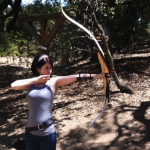Meet Miranda Nesler: Managing Editor Q&A
 As I mentioned in my first Editor’s Corner—and as you’ve likely noticed around the site—lots of changes at Wonders & Marvels!
As I mentioned in my first Editor’s Corner—and as you’ve likely noticed around the site—lots of changes at Wonders & Marvels!
I thought you might enjoy getting to know our new Managing editor, Miranda Nesler, who joined the team officially in May. Previously, Miranda was a guest contributor, and her posts include Silence and the Scold’s Bridle, Charles I and the Act of Dying, and Women Speaking from the Archives.
Holly Tucker: Hi, Miranda! So glad to have you on W&M, and excited to have a chance to chat with you. We’ve known each other for a long time, ever since you were studying at Vanderbilt University, but it’s good that the readers will get a chance to know you too. Why don’t you tell them a little about yourself?
Miranda Nesler: Sure, I’d be happy to. I earned my PhD in literature at Vanderbilt, with specialties in early modern gender, animal studies, material culture, and textual studies. For a number of years I taught in these fields and had contact with a number of talented students—at Vanderbilt and later at Ball State University—before making a career shift. Because archival research, writing, and editing really have my heart, I decided to take them up full time by freelancing and joining W&M.
HT: What is it that drew you to those fields?
MN: Honestly, the tensions and discomforts that are such a huge part of them. I was fascinated initially by the tensions that existed in early modern drama— between the play as a bodily action on stage as well as a written text, for example. This led to an interest in women, who during the period existed at the center of questions about performance but were so often prevented from public speech or participation in debates since they were considered “half-human.” Because so much of women’s experience wasn’t recorded in canonical “literature,” archival digging for their personal writings and then taking an experiential approach to material culture were key ways of accessing them. I could read a diary entry about being strapped into a busk or learning target archery at a country house, and then I could do it myself to gain a deeper understanding.

Archery Practice
HT: And those interests were part of the reason I thought you would fit here since our writers and readers are all fascinated by historical curiosities. Could you tell us a little bit about what you love about archives?
MN: There are so many things! Libraries and museums give you close, multi-dimensional contact with the historical figures you’re working with. You not only get to see their portraits or examine their clothing, but you even get to read their journals, learn their handwriting, or figure out their reading interests until you think you know them inside and out. Sometimes you even find a document, like a letter, a marginal note in a book, or someone else’s journal entry about that person, that shocks you by adding new dimension and reminding you just how real and how dynamic these people’s communities were. My love of queens Anna and Henrietta Maria were born out of the archives—I found them because I was working on men’s drama and they kept getting peripheral mention. After working with them more and more, I feel like they’re friends and collaborators in my work.
HT: I know I’ve had similar experiences, especially when I was writing Blood Work and now as I’m finishing this next one. You get attached because you start to realize that these people are complicated, not just “good” or “bad.” So now I have to ask my favorite question: If you could spend one day in the past, which day would it be and why?
MN: I knew this one was coming! February 2, 1609: the only performance of Anna’s Masque of Queenes. These masque performances were one-offs, huge preparation and expenditure put into one night; it’s part of why women were able to do them. Because the women were using their costumes, their bodies, the sound of their shoes to make noise in a space where they were barred from speech, you lose so much if you’re limited to the text. I’d love to see Anna and her ladies appear in Whitehall Palace dressed as Amazons and warriors, shocking the audience and “defending” the king from witches!
Miranda Garno Nesler is the Managing Editor at Wonders & Marvels. She is also a freelance writer, researcher, and editor who is working in collaboration with The James Shirley Project and oversees the animal studies blog Performing Humanity. In her spare time, you can find her with her overly affectionate labrador Poe, doing target practice at the archery range, curating her extensive shoe collection, or on Twitter @PerformHumanity.



